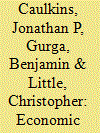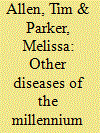| Srl | Item |
| 1 |
ID:
087463


|
|
|
|
|
| Publication |
2009.
|
| Summary/Abstract |
The fundamental activity of most drug dealers is buying drugs from a supplier and selling them on, usually in smaller lot sizes to multiple customers at a lower market level. Data on such 'cycles' of purchase and resale are derived from interviews with 65 dealers incarcerated in UK prisons. A power function relationship between price and transaction size is confirmed. Analyses reveal great consistency in proportional price markups across drugs and time, high cycle frequencies (typically weekly or more often) and importers who vertically integrate into the highest level of domestic distribution, so that an important share of their net revenues effectively derives from domestic distribution inside the UK, as opposed to importation per se.
|
|
|
|
|
|
|
|
|
|
|
|
|
|
|
|
| 2 |
ID:
105155


|
|
|
|
|
| Publication |
2011.
|
| Summary/Abstract |
The sixth MDG aims 'to combat HIV/AIDS, TB, malaria and other diseases'. The residual category of 'other diseases' has become the focus of intense interest, partly because it has provided an opportunity to increase resources for the control of the mostly parasitic 'neglected tropical diseases' (NTDs). Intense lobbying has secured large amounts of funding from donors, as well as generous donations of medicines from the major drug companies. A massive programme is now underway to treat the parasites of the poor in Africa via integrated vertical interventions of mass drug administration in endemic areas. The approach has been hailed as remarkably effective, with claims that there is now a real prospect of complete control and, for some NTDs, even elimination. However, a closer look at evaluation and research data reveals that much less is known about what is being achieved than is suggested. Competition between implementing organisations is leading to potentially counterproductive exaggerations about treatment coverage. Detailed local-level research in Uganda and Tanzania shows that actual rates of drug take-up among target populations are often lower than is necessary to effectively control the diseases, and that methods of drug distribution may even lead to active resistance to treatment. If current trends are not corrected, declining rates of NTD infection will not be sustained. Much more rigorous and effective monitoring is essential.
|
|
|
|
|
|
|
|
|
|
|
|
|
|
|
|